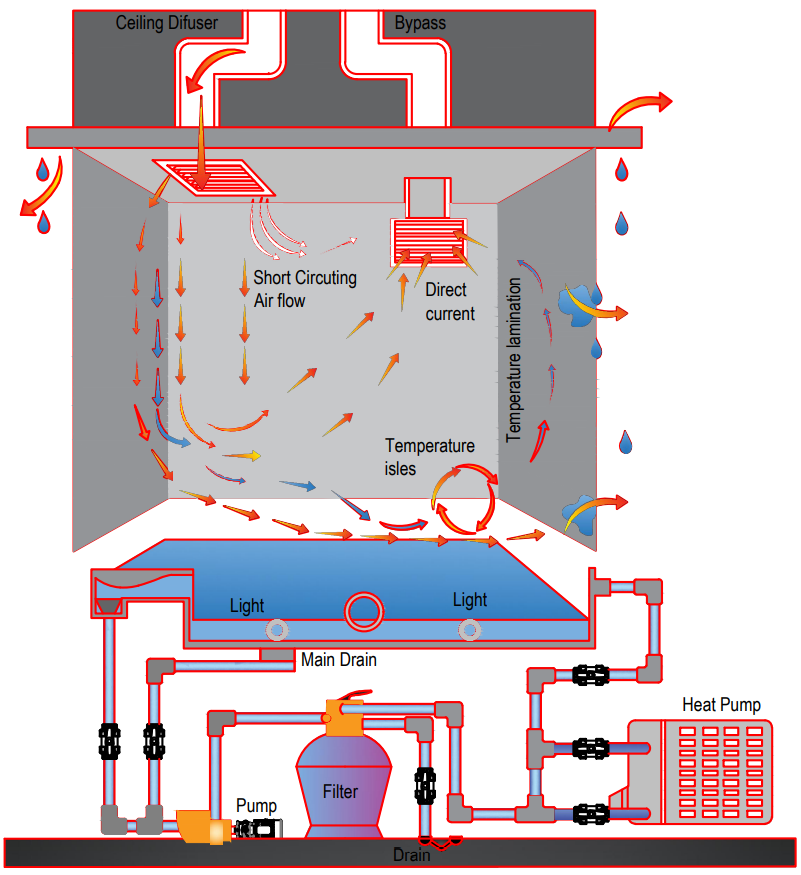With the rising global temperatures and the increasing cost of electricity, pool owners all over the world are exploring new ways to heat their swimming pools without incurring a huge energy bill. Solar energy, as well as open absorption systems where energy from moist air is recovered, have been explored as viable alternatives. But as of now, heat pumps appear to be the best solution.
You might think solar is a feasible and easy option but solar energy can reduce primary energy consumption only when used in countries with a warm climate where solar energy resources are more readily available and hence more profitable. They are not suitable in other regions.
In an open absorption system, the air passes through a liquid medium like lithium chloride/bromide which collects moisture from the air through adsorption. Adsorption is a process in which a gas or liquid solute accumulates on the surface of a solid or a liquid (adsorbent), forming a film of molecules or atoms (the adsorbate). It is different from absorption in which a substance diffuses into a liquid or solid to form a solution.
Water from the free surface of a swimming pool tends to evaporate due to the concentration difference between air and water. And this creates a cooling effect lowering the temperature of the air. Due to this the air has low heat content and is difficult to recover heat from it. The combined effects of evaporation and ventilation losses mean that the heating requirement for indoor swimming pool facilities will vary.
In countries with polar climates, the mechanical heat pump has proved to be a more eco-friendly and low-cost option for heating indoor swimming pools compared to open absorption systems. Replacing conventional air handling units with heat pumps for indoor swimming pools creates enormous energy-saving. While initial capital investment is high, studies show that savings can be seen within a short payback period of just two years.
Operation of mechanical ventilation systems
An indoor swimming pool continuously produces large quantities of chlorine or salt-laden water vapor due to the evaporation of the pool water. This can cause damage to a building from the inside out and can affect the air quality inside the building.
When the humidity goes too high, a building with cold surfaces or air leaks outside it can face numerous problems. When the moisture from the pool comes into contact with cold surfaces, it can cause rust, blistering of paint, deterioration of structural supports, and can affect the visual aesthetics of your building.
Naturally, most people may think that in order to fix these problems, you need to ventilate the space more, but in actual fact, the opposite is more effective.
There are 2 ways to deal with the swimming pool’s high humidity.
- Remove the moisture from the air
- Reduce the moisture from being emitted in the air.

Heat pump ventilation unit for swimming pool
Heat pumps use electricity to take in heat and move it from one place to another. They don't generate heat.
As the pool pump circulates the swimming pool water, the water drawn from the pool passes through a filter and towards the heat pump. The heat pump heater has a fan that draws in the air from outside and directs it to the evaporator coil. The liquid refrigerant inside the evaporator coil absorbs the heat from the outside air and becomes a gas. The warm gas now in the coil passes through the compressor. The compressor increases the heat, creating a very hot gas that then passes through the condenser. The condenser transfers the heat from the hot gas to the pool water which is cold circulating through the heater. The heated water then returns to the pool. The hot gas, as it flows through the condenser coil, returns to liquid form and back to the evaporator, where the whole process begins again.
Higher-efficiency heat pumps usually use scroll compressors versus the reciprocal compressors of standard units.
Heat pump pool heaters work efficiently as long as the outside temperature remains above 45ºF–50ºF. The cooler the outside air they draw in, the more energy they use.
Advantages of using a heat pump for heating a swimming pool
- A heat pump provides a good source of heat for ventilation that is independent of how the swimming pool is used (sports or recreational).
- Heat pumps use less energy than more environmentally friendly sources for heating ventilation air, but the primary energy index for heat pumps was higher by 8-13% compared to more environmentally friendly sources.
- A calculation of global costs over a period of 20 years shows that heat pumps have lower global costs, which makes them more economically viable
- Since this method of heating the air around the swimming pool is even more expensive than the most ecological ones in operation, it is a solution worth investing in after about two or three years.
.png)
No comments yet. Start a new discussion.